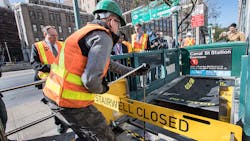Is NYC Transit prepped for the strain of a hurricane? MTA OIG thinks more is needed
For those living in New York City or working in the transit industry in October 2012, the images of Superstorm Sandy’s impact on subway and commuter rail infrastructure in the region can readily be brought to the mind’s eye: a boat marooned between tracks, stairs descending into a murky pit of water instead of a subway platform and train yards that resembled rushing rivers.
The Federal Transit Administration awarded more than $10 billion in emergency relief funds to transit agencies throughout the Northeast to aid in storm recovery efforts. Metropolitan Transportation Authority (MTA) received a total of $5.8 million in grants for projects to repair its system and make it more resilient.
However, an audit from the Office of the MTA Inspector General (MTA OIG) has determined there is “considerable work” required of New York City Transit (NYC Transit) to protect the subway system from flooding caused by future storms. In its report “Hurricane Preparedness: NYC Transit Can Improve Oversight of Flood Control Devices – Final Report,” MTA OIG credits NYC Transit with taking steps to expedite the design and delivery of hardening projects and recommends the agency “formalize and fine-tune its efforts” as it transitions from the construction and installation of flood control devices to an approach that maintains and monitors those devices.
“Almost 10 years after Hurricane Sandy, MTA has made great progress in fortifying its assets, however many opportunities remain for the MTA to improve upon its hurricane preparedness plans,” said Acting MTA Inspector General Elizabeth Keating. “Riders and NYC residents are relying on the MTA to deploy millions of dollars’ worth of flood control devices correctly and efficiently when the time comes, and a hurricane is forecast.”
MTA OIG recommendations
Following Hurricane Sandy, MTA and NYC Transit had to repair eight stations with major flooding damage, damage from flooded tunnels, washed out tracks and clear debris. To fortify its infrastructure against future storms, seawalls and flood walls were constructed and flood mitigation devices were installed such as retractable stairway covers for subway entrances, steel doors, steel logs that can be stacked at entrances to seal them and mechanical hatch doors were fitted to thousands of sidewalk vents in Lower Manhattan. MTA is investing $7.6 billion overall to protect the network against coastal flooding; $5.8 billion will be invested in NYC Transit.
The audit estimates NYC Transit has purchased more than 3,500 flood control devices at a cost of approximately $350 million and has installed 97 percent of those devices. The challenge, explains MTA OIG, is that each of these devices must be manually deployed, which requires a system shutdown 12 hours before a storm. Approximately 72 hours before a storm, NYC Transit would need to begin requisitioning supplies and checking staff levels.
MTA OIG issued 15 recommendations to NYC Transit including the following six:
- NYC Transit should improve its information system and procedures to better support the maintenance and deployment of all flood protection devices.
- The agency should improve the training provided to employees responsible for maintaining and activating the devices.
- Clear and rigorous standards should be established for contractors installing the flood mitigation devices.
- NYC Transit should develop efficient deployment routes and accurate time estimates to improve its Hurricane Plan.
- Improving the management of spare parts will ensure flood control devices remain in a state of good repair.
- NYC Transit should schedule deployment exercises regularly to train field crew members and assess the condition of the flood control devices.
In response to the MTA OIG audit, NYC Transit agreed with 14 of the 15 recommendations. The agency reported four had already been implemented and 10 will be implemented by the end of 2023. The one recommendation to be rejected concerned centralizing responsibility for the plan under a single entity. NYC Transit contends departments should retain control over plans because “preparedness activities between the Department of Buses and Subways are significantly different.” However, the agency counter proposed quarterly discussions between the two departments to coordinate preparedness activities.
“This report highlights the substantive steps NYC Transit has already taken in partnership with MTA Construction & Development to address a complex, yet vital task. NYC Transit is uncompromisingly committed to resiliency, investing $5.8 billion to harden the transit system against coastal flooding,” said MTA Spokesperson Michael Cortez.
The full audit is available on MTA OIG’s website.
---------
Story updated July 21, 2022; 10:50 a.m. to incorporate MTA quote.
About the Author

Mischa Wanek-Libman
Group Editorial Director
Mischa Wanek-Libman is director of communications with Transdev North America. She has more than 20 years of experience working in the transportation industry covering construction projects, engineering challenges, transit and rail operations and best practices.
Wanek-Libman has held top editorial positions at freight rail and public transportation business-to-business publications including as editor-in-chief and editorial director of Mass Transit from 2018-2024. She has been recognized for editorial excellence through her individual work, as well as for collaborative content.
She is an active member of the American Public Transportation Association's Marketing and Communications Committee and served 14 years as a Board Observer on the National Railroad Construction and Maintenance Association (NRC) Board of Directors.
She is a graduate of Drake University in Des Moines, Iowa, where she earned a Bachelor of Arts degree in Journalism and Mass Communication.
